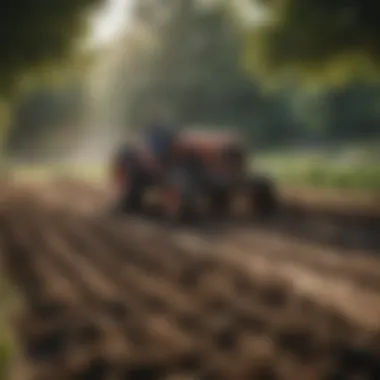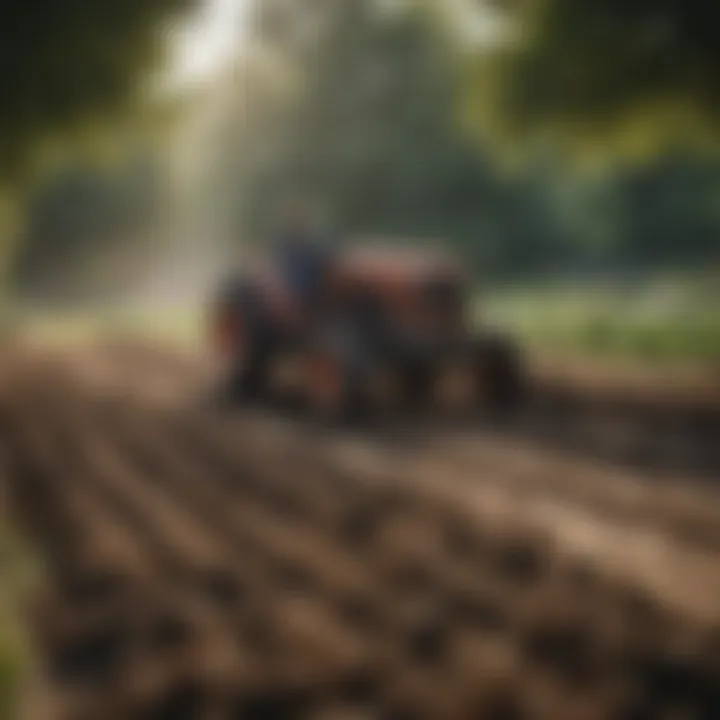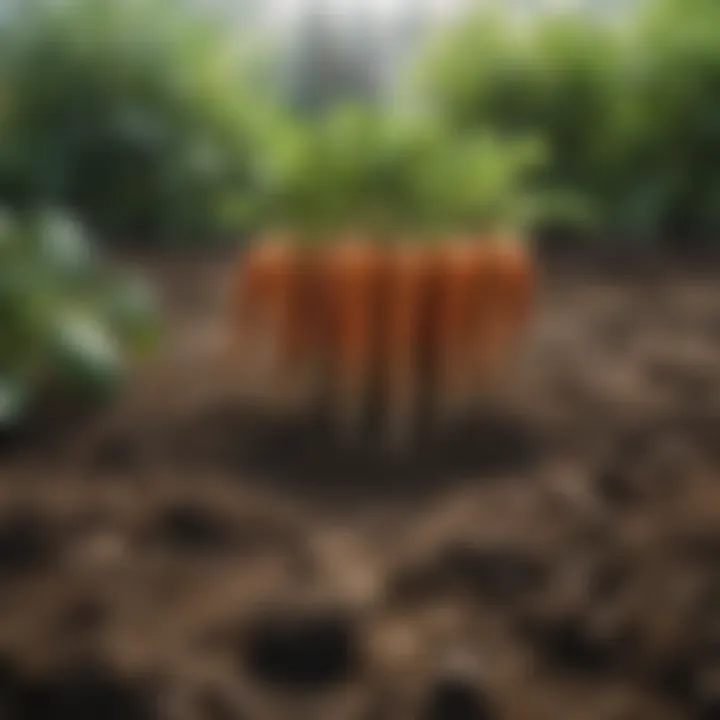Maximizing Vegetable Growth with Manure


Intro
Manure has long been a fundamental element in gardening, playing a critical role in enhancing soil fertility. This guide seeks to explore the effectiveness of manure in vegetable gardening, addressing its varied types, application techniques, and potential drawbacks. Many homeowners and gardening enthusiasts look for natural solutions to improve their vegetable yield. Manure offers not only nutrients but also aids in building soil structure and encouraging beneficial microbial activity.
Understanding how to select and apply manure properly is essential for ensuring optimal growth of vegetables. This article aims to provide well-researched insights, enabling you to make informed decisions for your gardens.
The Essence of Manure
Manure is organic matter derived from the feces of animals, and its use in gardening is rooted in history. It enriches the soil, making it more fertile. When incorporated into the soil, it can offer a gradual release of nutrients as it breaks down, contributing to sustainable gardening practices.
Key Benefits of Using Manure in Vegetable Gardens
Using manure effectively in your garden can enhance growth and improve overall health of the soil. Here are some benefits:
- Nutrient-rich: Manure provides nitrogen, phosphorus, potassium, and trace minerals essential for plant growth.
- Soil structure improvement: It improves the aeration, drainage, and moisture retention of the soil.
- Microbial activity: Manure fosters the growth of beneficial bacteria and fungi which aid in soil nutrient cycling.
Moreover, the process of composting manure can further enhance its benefits by eliminating pathogens and reducing odors.
Considerations Before Using Manure
It is essential to understand both the advantages and drawbacks before introducing manure into your vegetable garden. While manure is beneficial, improper usage can cause harm:
- Nutrient Overload: Applying too much manure can lead to nutrient leaching and imbalance in soil nutrients.
- Pathogen Risk: Fresh manure may contain harmful pathogens, which can pose health risks if not properly treated.
- Odor Issues: Some types of manure can produce unpleasant smells, particularly if used in excess.
Proper handling and thorough understanding of manure application methods can mitigate these risks.
In the following sections, we will delve deeper into specific types of manure, best practices for usage, and how to optimize your vegetable garden for a bountiful harvest.
Understanding Manure
Understanding manure is fundamental for any effective vegetable gardening endeavor. It serves as a natural fertilizer, providing key nutrients and enhancing soil quality. By grasping the intricacies of manure, gardeners can significantly improve their vegetable yield while fostering sustainability.
Defining Manure
Manure typically refers to animal dung or organic matter used for enriching soil. It plays a critical role in organic gardening, with its nutrient-rich composition that supports plant growth. In essence, it is an agricultural byproduct that, when properly utilized, promotes healthier soil and, ultimately, healthier plants. Understanding the definition of manure is crucial because it helps gardeners discern the right types and application methods suitable for their gardens.
Types of Manure
There are several types of manure, each with unique properties that cater to different gardening needs.
Animal Manure
Animal manure includes dung from livestock like cows, horses, chickens, and pigs. One of the primary characteristics of animal manure is its rich nitrogen content, essential for plant growth. This type of manure is particularly popular because it not only fertilizes but also enhances soil structure.
However, there are disadvantages as well. Animal manure can carry pathogens if not composted correctly, posing risks to human health. Thus, using well-composted animal manure is vital to mitigate these concerns. The balance of nutrients in animal manure can also sometimes lead to nutrient runoff, especially if applied excessively.
Green Manure
Green manure consists of cover crops that are grown specifically to be tilled back into the soil. This practice adds organic matter while improving soil fertility. The key feature of green manure is its ability to fix nitrogen from the atmosphere, making it highly beneficial for subsequent vegetable crops. Additionally, it helps prevent soil erosion and improves soil tilth.
A downside to green manure is the requirement for careful timing in planting and tilling. If not managed properly, there could be competition for nutrients and water with the primary crops. However, its advantages in enriching soil are significant.
Composted Manure
Composted manure is the result of decomposing animal waste combined with carbon-rich materials such as straw or leaves. This type offers a balanced nutrient profile and more uniform application compared to raw manure. The main benefit of using composted manure is its lower risk of pathogens and minimal odor, making it a less controversial choice for gardeners.
One notable characteristic is its ability to improve soil structure significantly. It enhances moisture retention, which is crucial for vegetable growth. On the flip side, the composting process requires time and careful management, which may deter some gardeners who prefer quicker solutions.
In summary, an understanding of these various types of manure enables gardeners to make informed decisions tailored to their specific gardening practices and goals. Incorporating the right type of manure can be transformative for soil health and, ultimately, for vegetable production.
Nutrient Composition of Manure
The nutrient composition of manure is a fundamental aspect that influences its effectiveness in enhancing vegetable gardens. Understanding what elements are present allows gardeners to tailor their application to meet specific plant needs. The composition typically includes essential macronutrients and micronutrients that play vital roles in plant growth, health, and yield.
Nutrient-rich manure can greatly improve soil quality, helping not only in plant development but also in fostering a diverse ecosystem within the soil. Careful consideration of what each nutrient contributes is important. This section explores essential nutrients such as nitrogen, phosphorus, and potassium, followed by a discussion on micro-nutrients and the significance of organic matter.
Essential Nutrients


Nitrogen
Nitrogen is a key component of many organic compounds critical for plant growth. It contributes to the formation of chlorophyll, the pigment responsible for photosynthesis, allowing plants to convert sunlight into energy. Moreover, nitrogen promotes the growth of leafy green vegetation, making it especially beneficial for leafy vegetables.
Nitrogen is generally fast-acting in its natural form and commonly found in manures such as cow, chicken, and horse manure. Its unique feature is its ability to facilitate rapid growth in early plant stages, which is essential for many vegetable varieties. However, an excess of nitrogen can lead to overstimulation and may cause problems such as nutrient burn or susceptibility to pests.
Phosphorus
Phosphorus is critical for root development, flower formation, and fruit maturation. It enhances overall plant metabolism and energy transfer. This nutrient is particularly important during the early stages of growth and is necessary for setting fruit, which is crucial for vegetable production.
Phosphorus in manure comes primarily from animal waste, specifically from livestock. The key characteristic of phosphorus is its availability to plants, as it is often found in a form that is readily absorbed. One disadvantage is that phosphorus can be less mobile in soil, meaning that timely application and proper incorporation into the soil are essential for optimal uptake.
Potassium
Potassium is essential for water regulation and overall plant health. It plays a role in the synthesis of proteins and starches and helps to strengthen plant cell walls. This nutrient is vital for the resilience of plants against diseases and environmental stressors.
Sources of potassium in manure include cow and chicken manure, among others. Its distinctive advantage lies in its ability to enhance the quality of fruits, improving flavor and texture, which is particularly important for vegetable yields. However, a deficiency or imbalance in potassium levels can lead to physiological disorders in plants, affecting growth and production.
Micro-nutrients and Organic Matter
Micro-nutrients are trace elements that, although required in smaller amounts, are critical for various physiological functions in plants. These may include iron, manganese, zinc, and copper, among others. Organic matter, on the other hand, is decomposed plant and animal material, which adds to soil structure, improves moisture retention, and fosters beneficial microbial life.
Together, the micro-nutrients and organic matter present in manure can significantly enhance soil fertility. They improve nutrient cycling and promote healthy microbial activity, which in turn enhances nutrient availability to plants.
Manure, when composted or well-aged, generates beneficial microbes that aid in nutrient breakdown and availability in soil, forming a crucial part of sustainable gardening practices.
Benefits of Using Manure
Using manure in vegetable gardening is essential for enhancing soil health and improving plant growth. It plays a significant role in providing not only essential nutrients but also affects physical properties of the soil. The benefits of manure can be substantially felt across multiple dimensions of gardening. It can lead to better yields, improved ingredient quality, and sustained soil fertility.
Improving Soil Structure
Manure significantly contributes to the structure of the soil. The organic matter present in manure helps bind soil particles together, creating a crumbly texture that enhances aeration and root penetration. Good soil structure allows water and nutrients to move more freely, which is essential for plant growth. Improved soil structure leads to reduced erosion risk and promotes healthier root systems for vegetables. Regular application of manure can transform heavy clay soils into more manageable and productive gardening spaces. This physical change can dramatically alter how your garden performs over time.
Enhancing Water Retention
Water retention is critical in successful vegetable gardening. Manure can help soil retain moisture more effectively. When organic matter decomposes, it forms humus, a substance that holds water efficiently. This not only reduces the frequency of watering needed but also protects plants during dry spells. Increased water retention minimizes stress on vegetable crops, thus allowing them to thrive throughout various growth stages. Additionally, healthy soil, rich in manure, will better support different water-holding capacities, ensuring a consistent supply for plants.
Increasing Microbial Activity
The introduction of manure into the soil creates a vibrant ecosystem of microorganisms. These microbes are vital for breaking down organic materials, making nutrients available to plants. They play a crucial role in nitrogen fixation and further enhance the soil’s nutrient profile. The increase in microbial activity leads to improved nutrient cycling in the soil, supporting healthier plants. An active microbial community also aids in suppressing plant diseases by outcompeting harmful pathogens. This boost in soil life is essential for sustainable gardening practices as it fosters long-term soil fertility and plant health.
Overall, the benefits of manure are profound and multi-dimensional. By understanding these effects, gardeners can make informed decisions about their soil management practices.
Application Methods
Understanding the various methods of applying manure is crucial for optimizing its benefits for vegetable gardens. Each application method has its own advantages and specific considerations. Proper application not only ensures nutrient availability but also minimizes risk of issues such as nutrient runoff, which can harm the environment. By choosing the right method, gardeners can enhance soil health and improve plant growth effectively.
Direct Application
Direct application refers to spreading manure directly onto the garden bed. This method allows for immediate nutrient availability to plants. However, it is important to apply manure at the right time to avoid burning plants with excess nitrogen. Typically, well-aged manure is preferred to reduce the risk of pathogens and nutrient loss. Apply in moderate amounts to avoid over-fertilization, which can lead to nutrient leaching and environmental contamination.
- Timing: Best applied in early spring before planting.
- Volume: Use one to two inches, depending on the quality of the manure.
- Ideal Manure: Cow or horse manure are often recommended for direct application due to their relatively balanced nutrient content.
Ensure to incorporate some form of tilling after application to enhance nutrient absorption into the soil.
Incorporating into Soil
Incorporating manure into the soil is another effective method of application. This technique involves mixing manure with soil, allowing the nutrients to integrate well for better absorption. It can promote even nutrient distribution and improve soil structure. This process also helps reduce odors and risks of pests attracted to surface manure.
To incorporate manure into soil:
- Tilling: Use a garden fork or tiller to mix manure.
- Depth: Incorporate to a depth of at least six inches.
- Timing: Ideal after the last frost and before planting to allow nutrients to stabilize in the soil.
By incorporating manure, gardeners create a rich, nourished environment which promotes healthier vegetables.
Composting Techniques


Composting is a sustainable method that not only utilizes manure but also reduces potential pathogens and weeds that might be present in raw manure. The composting process transforms raw manure into a nutrient-rich soil amendment, which can be applied later without the risk of overwhelming plants.
Key techniques in composting manure include:
- Aeration: Ensuring proper airflow is crucial for successful composting. Turning the pile regularly helps maintain aerobic conditions.
- Temperature Monitoring: The compost should reach temperatures of at least 130°F (54°C) to kill pathogens effectively.
- Moisture Balance: Maintaining the right moisture level is important. Too dry might slow the process, while too wet can lead to anaerobic conditions.
Using composted manure boosts soil organic matter, improves moisture retention, and enhances microbial activity, crucial elements for vibrant vegetable growth.
"Composting is one of the best ways to recycle nutrients while improving garden soil efficiency."
Timing of Manure Application
Understanding the timing of manure application is essential for maximizing its benefits in vegetable gardening. Applying manure at the right time allows gardeners to optimize nutrient availability, improve soil quality, and support healthy plant growth. Proper timing ensures that the nutrients are accessible to the plants when they need them most.
Before Planting
Applying manure before planting provides an excellent foundation for your vegetable garden. This phase is critical as it allows the nutrients to integrate into the soil ahead of planting. Well-composted manure can enhance soil structure, replenish organic matter, and introduce beneficial microbes that help with nutrient breakdown and plant health.
In this stage, it is advisable to incorporate manure into the soil rather than apply it as a top dressing. This incorporation ensures that the nutrients are mixed well within the topsoil, where young roots will grow. Typically, applying manure several weeks before sowing seeds or transplanting seedlings is recommended. This time allowance helps in reducing any potential pathogen risks, given that the composted manure will have time to break down further.
During Growing Season
The growing season is another crucial time for manure application. During this period, plants are actively growing and have significant nutrient demands. However, the application must be thoughtful to avoid nutrient spikes that could harm the plants. Top-dressing with a thin layer of well-composted manure is effective here. This method supplies nutrients without disturbing the plant roots or soil microbes excessively.
Monitoring plant growth is vital. If you notice signs of nutrient deficiency, such as yellowing leaves, it may indicate the need for additional manure. However, it is critical to apply it cautiously and preferably after rain or with adequate soil moisture. This timing helps in gradual nutrient release and minimizes the risk of nutrient runoff.
Post-Harvest Applications
Post-harvest applications serve as a means to replenish nutrient reserves in the soil. After harvesting your vegetables, your garden's soil can be somewhat depleted of essential nutrients. By applying manure during this time, you not only restore nutrients but also enhance soil health ahead of the next planting season.
This method may require applying manure as a cover crop, which enriches the soil while protecting it from erosion. Fibonacci theories exist in this method by mixing multiple manures to balance nutrients effectively. Completing this process a few weeks before the next planting will allow any remaining pathogens to reduce and give the soil time to rejuvenate.
"Proper timing of manure application can transform the productivity of your vegetable garden, ensuring that plants have access to the nutrients they need throughout their growth stages."
By understanding these timing aspects, gardeners can effectively utilize manure, ensuring its benefits are maximized while minimizing potential drawbacks. This strategic approach to timing ensures that vegetable gardens thrive, providing abundant harvests year after year.
Potential Drawbacks
Understanding the potential drawbacks of using manure is crucial for any gardener. While manure can enrich soil and promote healthy plant growth, it also carries risks that should not be overlooked. Recognizing these risks enables gardeners to make informed decisions that balance benefits with safety, ensuring that gardens remain productive and environmentally responsible.
Pathogen Risks
One significant concern with manure is the potential presence of pathogens. Manure may contain harmful bacteria, viruses, or parasites that can affect both plants and humans. For instance, pathogens such as E. coli, Salmonella, and Listeria can thrive in animal waste. If used on vegetable gardens without proper treatment, these pathogens can contaminate crops, leading to foodborne illnesses.
To mitigate these risks, it is essential to compost manure thoroughly before using it in the garden. Heating the manure to specific temperatures over time can kill most pathogens, making it safer for application. Additionally, gardeners should allow a resting period between applying raw manure and planting crops, generally waiting at least 90 to 120 days. This strategy helps reduce the likelihood of contaminating vegetables with pathogens.
Nutrient Imbalance
Another drawback of manure usage is the risk of nutrient imbalance. Different types of manure contain varying concentrations of nutrients. For example, chicken manure may have high nitrogen levels, while cow manure is lower in nitrogen but higher in other nutrients. Over-application of a specific type of manure can lead to nutrient excesses, which may harm plants or contribute to soil toxicity.
This nutrient imbalance can result in poor plant growth, reduced yields, or even chemical burn to plants. Therefore, it is essential to conduct soil tests before applying manure. Understanding the current nutrient levels in the soil allows for more precise application of manure, ensuring that plants receive the necessary nutrients without overwhelming them. To avoid nutrient imbalances, consider mixing different types of manure or using them in rotation based on the plants being grown.
Environmental Considerations
Environmental impacts are another aspect worth addressing. When manure is applied improperly, it can lead to nutrient runoff. Heavy rainfall can wash excess nutrients, particularly nitrogen and phosphorus, into nearby waterways. This runoff contributes to problems such as algal blooms, which deplete oxygen in water bodies, harming aquatic life.
To prevent such issues, gardeners should adopt best practices for manure application. This includes avoiding application before heavy rain, using buffer strips, and applying manure at recommended rates. Choosing to apply manure during dry conditions can further reduce the chances of runoff.
Furthermore, integrating manure use into a sustainable garden system encourages responsible stewardship of the land. Practicing crop rotation and using cover crops can help maintain soil health while minimizing environmental impact.
"Understanding potential drawbacks of manure use is necessary for creating healthy vegetable gardens and protecting the environment."
Sustainable Practices in Manure Use
The utilization of manure in vegetable gardening is not merely about application; it encompasses sustainable practices that safeguard long-term soil health and productivity. Sustainable practices in manure use involve methods that harmonize agricultural productivity with environmental conservation. Such practices ensure that the benefits derived from manure are not counterbalanced by adverse environmental impacts. They promote a more responsible approach to gardening, maximizing the potential of nutrient-rich manure while minimizing risks associated with its use.
Integrating Crop Rotation


Crop rotation is a key element in sustainable agriculture. By rotating different types of crops in your vegetable garden, you can improve soil health and enhance overall yield. This practice can break the cycle of pests and diseases that target specific plants. It also helps make better use of nutrients in the soil. For example, legumes introduced in the rotation add nitrogen back to the soil, benefiting the following crops. Using manure in conjunction with crop rotation optimizes nutrient absorption and maintains a balanced ecosystem.
Utilizing Cover Crops
Cover crops serve multiple functions, such as improving soil structure, suppressing weeds, and controlling erosion. When combined with manure, cover crops can capture excess nutrients, preventing them from leaching into water systems. This leads to a more effective use of manure applications, ensuring that nutrients are available for the vegetable crops at the right time. Additionally, cover crops enhance microbial activity in the soil, which can improve the breakdown of organic matter, promoting better nutrient availability for future crops.
Minimizing Soil Erosion
Soil erosion poses a significant threat to the health of any garden, particularly those reliant on manure for fertility. Implementing practices to minimize soil erosion is crucial when using manure. This can be achieved through maintaining healthy plant covers, using mulch, and ensuring proper drainage. Planting vegetative barriers like grasses along contours can also be effective. These measures help retain soil structure while maximizing the benefits of manure, as well as preserving topsoil for optimal crop performance.
A sustainable approach to manure use guarantees that the benefits extend far beyond current crop yields by ensuring the health of the land for future generations.
By integrating these sustainable practices, gardeners can significantly enhance the effectiveness of manure applications, paving the way for healthier soil and more productive vegetable gardens.
Selecting the Right Manure for Vegetables
Selecting the appropriate manure is crucial for enhancing vegetable growth. Different types of manure provide varying nutrient profiles and can impact soil health differently. The right choice of manure can improve yield and crop quality, while a poor choice may lead to nutrient imbalances or other gardening challenges. Considering specific elements such as nutrient content, source, and application method is vital to optimizing the benefits of manure in a vegetable garden.
Evaluating Manure Sources
When choosing manure for vegetable gardens, evaluating the source is essential. Manure can come from several different animals, such as cows, chickens, horses, and pigs. Each type has its properties and nutrient levels.
- Cow Manure: High in organic matter, good for soil structure. Commonly used in gardens.
- Chicken Manure: Very rich in nitrogen, but needs to be composted before applying to prevent burning plants.
- Horse Manure: Lower in nutrients than cow or chicken manure but adds bulk and improves soil texture.
- Pig Manure: High in nitrogen but can carry a strong odor and requires careful management.
It is critical to source manure from animals that have been well-fed and managed. Manure from animals fed with antibiotics or hormones can lead to undesirable effects on your vegetables. Additionally, consider the environmental conditions of the source. Manure collected from clean, well-maintained facilities will likely be more beneficial than that from overcrowded or poorly managed sources.
Assessing Nutritional Content
Nutritional content in manure directly affects plant growth. Understanding the levels of key nutrients can guide your selection. Here are the primary nutrients to consider:
- Nitrogen (N): Essential for leaf growth and overall plant vigor. Different manures have different nitrogen contents. Chicken manure has one of the highest levels, while horse manure has less.
- Phosphorus (P): Important for root development and flowering. Ensure the manure source has balanced phosphorus content, which is usually lower in most animal manures than nitrogen.
- Potassium (K): Vital for plant health and disease resistance. It might be abundant in some types of manure, adding an extra layer of benefit for your vegetables.
Always consider conducting a soil test to determine existing nutrient levels in your garden. This will help fine-tune the amount and type of manure you should use.
Storage and Handling of Manure
Effective storage and handling of manure plays a vital role in the overall quality and performance of its application in vegetable gardens. Proper methods not only preserve the nutrient composition but also minimize potential health risks and environmental impacts. Understanding how to store manure correctly is thus essential for those who aim to enhance their garden's productivity while maintaining responsibility in their practices.
Best Practices for Storage
- Choose the Right Location: Manure should be stored in a dry, well-drained area away from bodies of water. This approach helps prevent nutrient runoff and contamination of water sources.
- Use Contained Structures: Utilizing bins or covered storage helps limit odour while protecting the manure from excessive moisture and pests. A well-designed structure should allow air circulation to prevent anaerobic conditions that can lead to unpleasant smells and loss of nutrients.
- Monitor Moisture Levels: The moisture content of manure is crucial. Too wet manure can lead to nutrient leaching, while too dry manure may not break down properly over time. Use a moisture meter to ensure optimal conditions.
- Temperature Regulation: High temperatures can help in composting manure but must be controlled to prevent losses in nutrient quality. Regularly check temperatures to keep them within a desired range, ideally between 130°F and 160°F for effective composting.
- Regular Turning: If you are composting your manure, turning it periodically will reintroduce oxygen. This action promotes aerobic breakdown, helping keep the process efficient and reducing the risk of pathogens.
Following these best practices will facilitate safe and effective storage that enhances the utility of manure in vegetable gardens.
Safety Precautions
Handling manure requires careful consideration of safety measures. Proper precautions are paramount to avoid health hazards associated with pathogens and contaminants. Here are a few critical safety guidelines:
- Wear Protective Gear: Always use gloves, masks, and suitable clothing when handling manure. This practice minimizes exposure to harmful bacteria and ammonia fumes.
- Avoid Direct Contact: Ensure to reduce direct contact with manure to prevent any potential health implications. Use tools like shovels or forks to handle it.
- Proper Hygiene Practices: After handling manure, wash your hands thoroughly with soap and water. This simple step helps prevent the spread of pathogens.
- Educate Yourself on Pathogen Risks: Familiarize yourself with potential pathogens often found in animal waste, such as E. coli and Salmonella. Knowledge can guide better handling practices and reduce risks.
- Store Safely Away From Children and Pets: Maintain stringent access controls to manure storage to keep children and pets away from potentially hazardous materials.
By adhering to these safety precautions, gardeners can mitigate health risks and ensure a more secure gardening environment. Proper handling and storage are essential to unlock the positive benefits of manure without compromising garden safety.
Case Studies
Case studies are essential in understanding the practical application of manure in vegetable gardening. They provide real-world examples that illustrate both positive outcomes and challenges faced by gardeners. By looking at specific instances, gardeners can gather insights on practices that can lead to success or failure. These narratives not only validate theoretical concepts discussed in earlier sections but also illuminate practical considerations and strategies in the realm of vegetable gardening.
Successful Vegetable Gardens Using Manure
Many gardeners have seen significant improvement in their vegetable yields by using manure. For instance, a community garden in California adopted a method incorporating horse manure into their soil preparation. This initiative resulted in a notable increase in the growth rate and health of tomato plants compared to those grown in untreated soil. The gardeners reported rich, flavorful produce, encouraging more local gardeners to adopt this method.
Another example can be found in a suburban garden in Ohio, where chicken manure was used as a supplement. The gardener noted that this particular type of manure provided high nitrogen levels, which led to a robust growth of leafy greens. Regular soil testing also ensured that the nutrient levels remained balanced, further enhancing the benefits derived from using manure.
These examples underscore the importance of selecting the right type of manure and ensuring proper application methods. Effective application allowed for nutrient-rich soil that supported not just healthy plants, but also a thriving ecosystem in the garden.
Lessons Learned from Failed Attempts
Not every experience with manure leads to successful gardening outcomes. Several gardeners learned through trial and error. One common issue occurred when fresh manure was applied directly to the soil without proper composting. This practice led to an influx of pathogens and pests, which adversely affected plant health and growth. Recognizing this mistake, the gardener switched to aged manure, which produced much better results.
In another case, a gardener in Florida used duck manure in their vegetable garden. Initially, they saw vigorous growth, but over time, the high nitrogen content without adequate balance caused nutrient burn in plants. This resulted in stunted growth and poor yields. In response, they adjusted their approach by incorporating additional organic matter to create a more balanced nutrient profile.
These lessons highlight the significance of understanding manure characteristics and application timing.
"Appropriate management and knowledge is key to using manure efectively in vegetable gardening."
By learning from both successes and failures, gardeners can refine their practices and optimize their experiences with manure, ultimately leading to better vegetable production.



